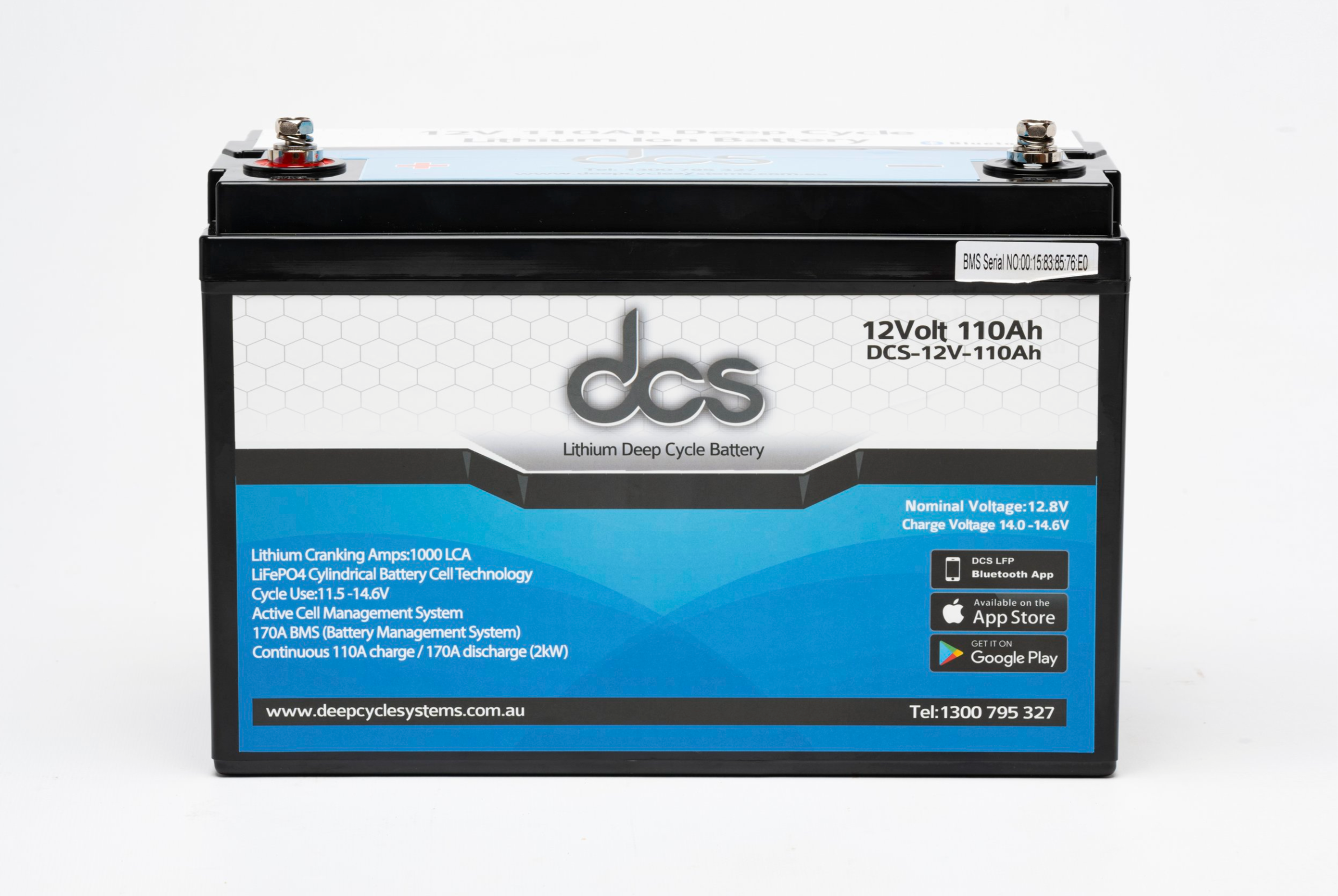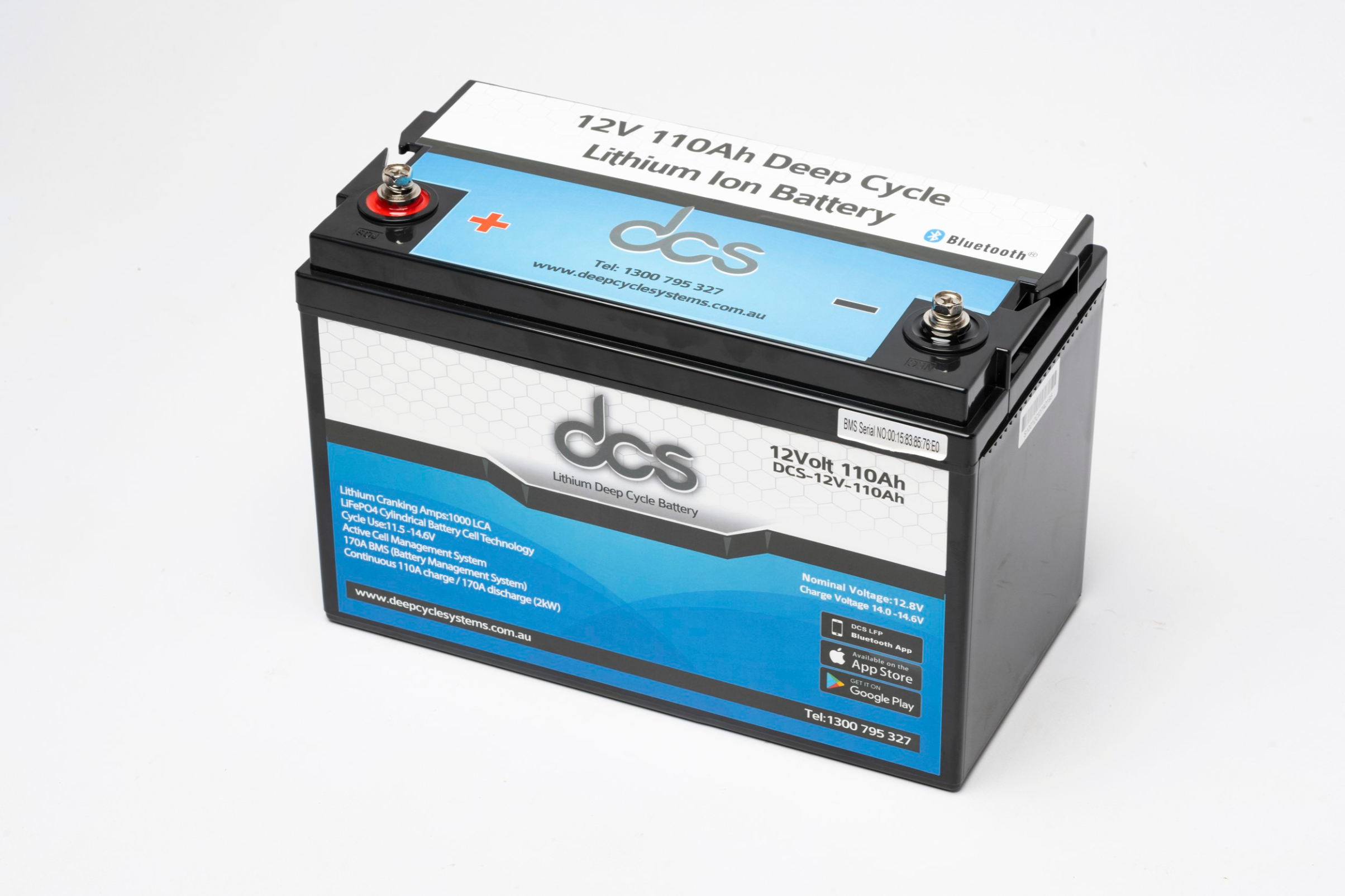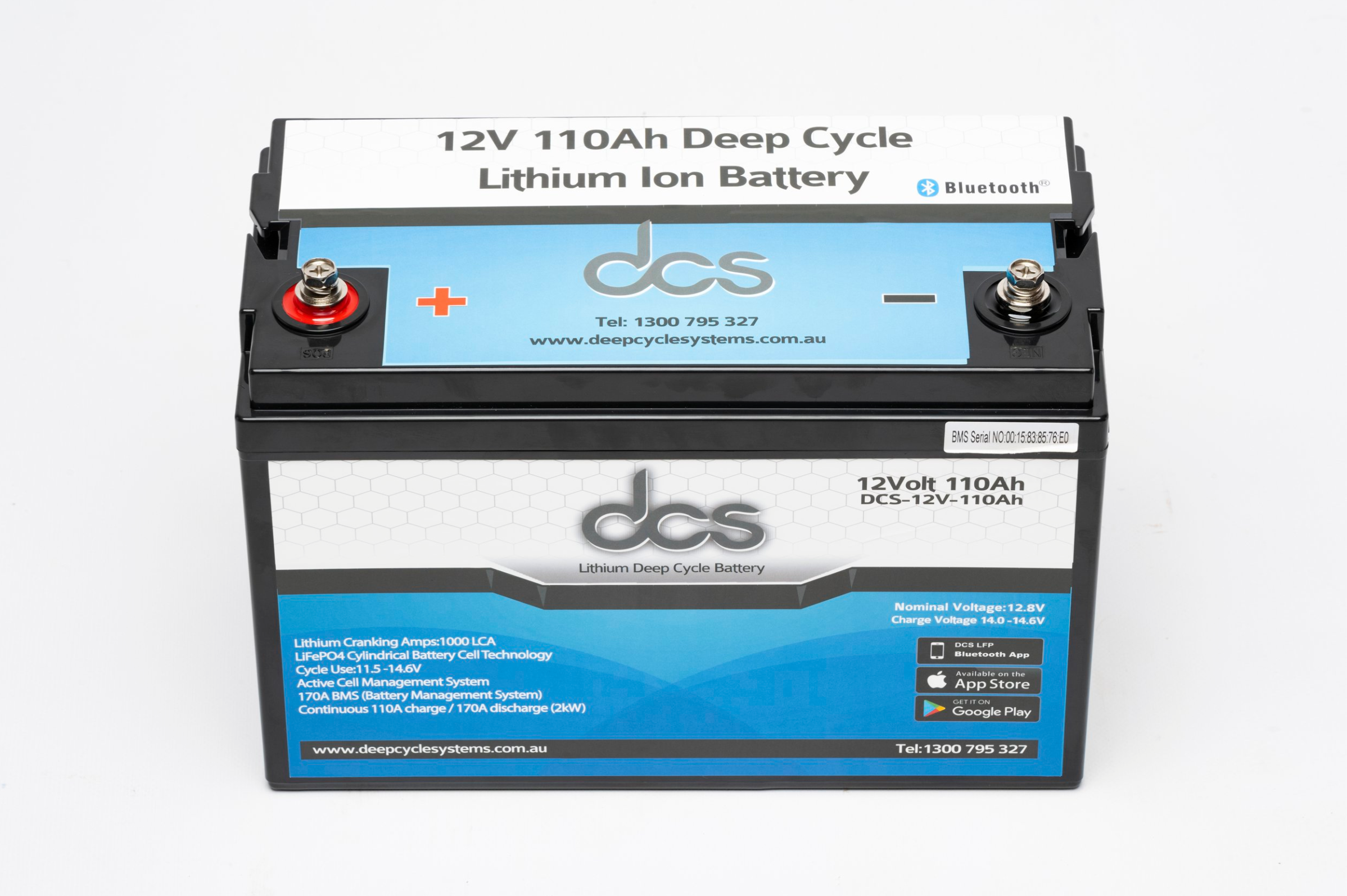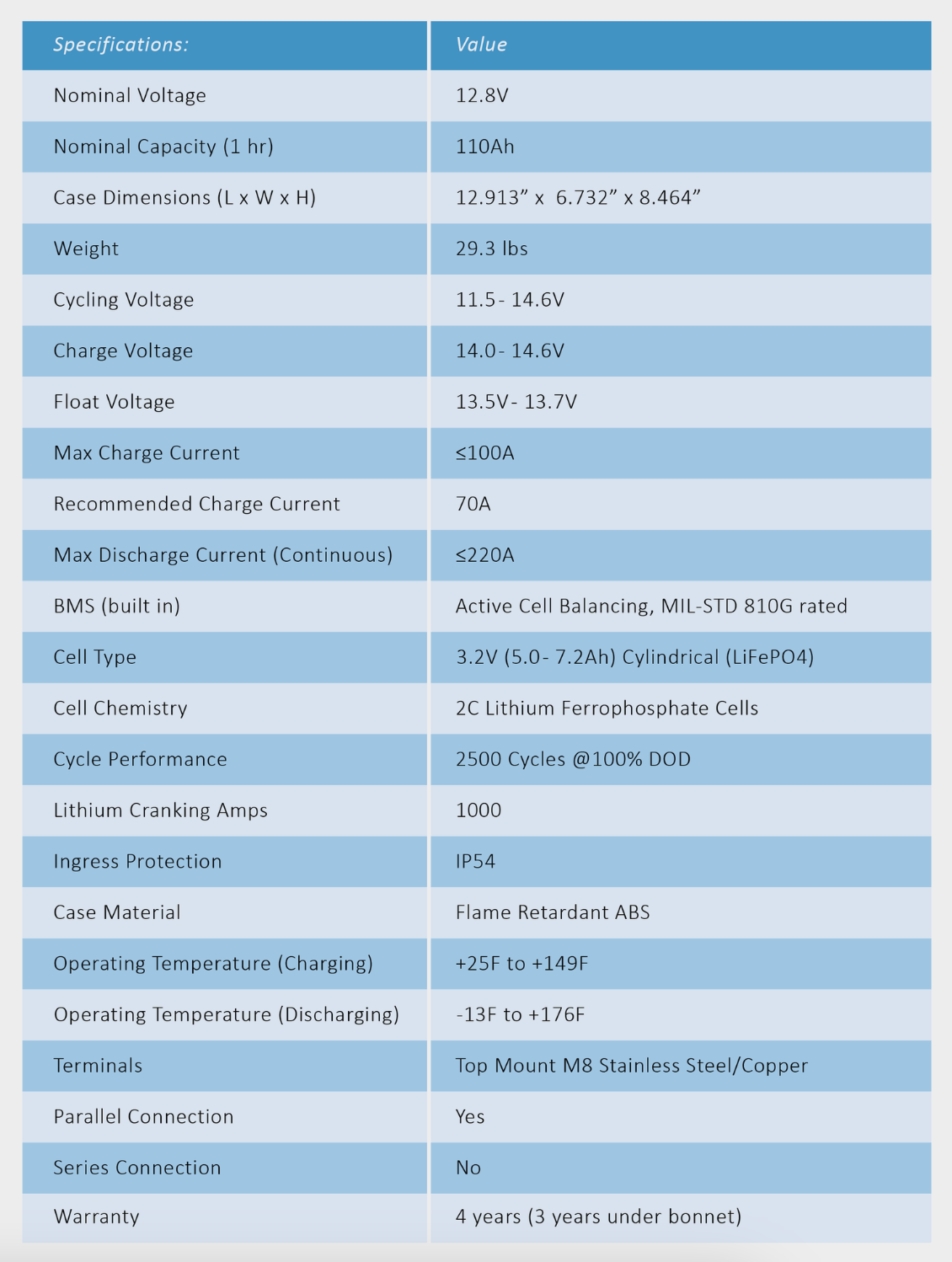



DEEP CYCLE SYSTEMS | 12V 110AH Deep Cycle LiFePO4 Battery
SELECT OPTIONS
Deep Cycle Systems (DCS) is a technology company in Mount Tamborine, Queensland, Australia that designs, develops, tests and manufactures their own range of high performance lithium Ion batteries for a wide variety of vehicle applications.
DCS 12V 110AH Super Slim LIFEPO4
A Deep Cycle Lithium Iron Phosphate (LiFePO4/LFP) Starting battery with 1000 LCA, an impressive 100A Max Charge Capacity and a Max Discharge Capacity of 220A. This battery uses 2C LFP Cells for an estimated Cycle Performance of 2500 Cycles @100% Depth of Discharge (DOD).
All DCS Batteries come standard with our custom, proprietary and MIL vibration tested 200A Battery Management System (BMS) which enables comprehensive real time monitoring via BLE 4.0 technology of the following: State of Charge (SOC), Time remaining, Battery pack Voltage, Power and Current, MOSFET temperature and Individual Cell Status.
This battery has a 4-year warranty (3 years when installed in engine bay).
What Makes DCS LIFEPO4 Batteries Different?
1. DCS Batteries are uniquely capable. DCS makes the very first Lithium Battery that is truly capable of handling winching applications. All DCS Deep Cycle Batteries are capable of 1000 - 1400 LCA depending on the model.
2. DCS Batteries are built for durability. Developed for Military and Naval applications, our batteries use our own MIL Spec tested BMS and are tested for use in the harsh elements of the Australian Outback and have an Operating Temperature range of -22F to +176F.
3. DCS Batteries have a long life span. A long life span and high durability makes DCS batteries cost effective. The majority of our battery models have a 2500 cycle life span @ 100% Depth of Discharge. Calculated at an average use of 200 cycles/year that comes out to ~12.5 years.
It is very important to note that not all life span claims are equal. Each manufactures use different parameters for testing and many claims are based on theoretical, ideal conditions and do not account for cell chemistry aging (2% per year if used, 3% if unused).
4. DCS Batteries are cost effective. The only true and accurate way to calculate cost is to apply the purchase price to the overall lifetime use of the product. The lifetime cost of our 12V 100Ah battery is $0.32/kWh. For comparison, an Odyssey 34-PC1500 AGM battery has a lifetime cost of $1.93/kWh.
5. DCS Batteries are designed and engineered in-house from the ground up. All DCS batteries contain our own custom and proprietary Cell (CMS) and Battery Management System (BMS) that is MIL-STD 810G tested, with active cell balancing and continuous output of 200A.
Frequent Asked Questions
Are Lithium Batteries safe?
While there are six different types of Lithium chemistries, DCS exclusively uses Lithium Ferrophosphate (LFP) which is a flame retardant, stable, safe and proven cell chemistry that has a very good energy density around 325 Wh/L. This cell chemistry can be engineered for various applications by adjusting the ratio of elements to provide high performance characteristics.
What are the advantages to using Lithium Cell Chemistry?
LFP Chemistry has many advantages over Lead/AGM chemistry. Here are a few of them:
• Lithium Chemistry has a higher energy density than Lead/AGM (3:1) which means a 100Ah LFP battery equals 300Ah of AGM chemistry in terms of power output. This results in both space and weight savings to achieve an equivalent power output.
• Lithium Chemistry offers a much longer life span than Lead/AGM, often 5-10x longer depending on how it is being used.
• An LFT battery also weighs roughly one third less than a lead acid/AGM battery.
• Lithium Chemistry has higher Depth of Discharge (DOD) than Lead/AGM. A Deep Cycle LFP battery can safely be depleted to 0% without permanently damaging the battery.
• Lithium Chemistry has 100% more usable capacity compared to Lead/AGM since the latter cannot be depleted past 50% without permanently damaging the battery.
To learn more about the advantages of Lithium and LFP technology please check our blog section.
What are the disadvantages to Lithium Cell Chemistry?
LFP chemistry cells require a Battery Management System (BMS) in order to stay balanced. LFP chemistry also doesn’t perform well in extreme temperatures, particularly low temperatures. While most competitors LFP batteries can operate down to 32F and -4F, All DCS LFP Batteries operate down to -22F, unheated. While LPF Cell chemistry has a much higher energy density than Lead/AGM chemistry, it still has a slightly lower energy density and a higher cost compared to lithium ion chemistry.
What is Cycle Life?
Cycle life is defined as the number of cycles (with a 100% DOD) a cell can perform before its capacity drops to 80% of its initial specified capacity and then starts to visibly reduce its performance.
You complete one charge cycle when you've used (discharged) an amount that equals 100% of your battery's capacity, but not necessarily all from one charge. For instance, you might use 75% of your battery's capacity one day, then recharge it fully overnight.
How long will my Lithium Battery last?
The lifetime performance of a Lithium battery can vary greatly and depends on a complex set of physico-chemical processes that are influenced by many operating variables including but not limited to charge rates and environmental temperature.
In a recent controlled study, LFP cells exhibited substantially longer cycle life spans than other chemistries under the examined conditions: between 2500 to 9000 EFC (Equivalent Full Cycle). The study considered the influence of three of the variables most readily controlled during operation—temperature, Depth of Charge (DOD), and discharge rate.
The wide spread in the data for each of the chemistries indicates that even within the manufacturer-specified operating bounds there is significant dependence on the specific cycling conditions.
DCS designs, manufactures and tests our LFP batteries specifically to conform to the strict requirements of military and naval applications. We intentionally test for the harshest of conditions because that is what our batteries are designed for.
All DCS LFP batteries are rated for a minimum of 2500 cycles @ 100% DOD. Under more favorable conditions and using a more optimal Cycle Range ( 30% - 60% DOD) one can expect to see a significant increase in Cycle Life Performance.
What is a C-Rating?
A C-rating is a defined measurement of how quickly energy can be charged and discharged from a battery. The chemical make-up of the cell, the overall design of the cell and the layering inside dictates the C-rating. A battery with a higher C-rating have less internal resistance, which means they generate less heat for a given load, which means they can take a bigger load.
A higher capacity battery with higher C ratings can deliver power more efficiently, with less power wasted as heat, at any load. The DCS Marine and Hybrid Series use 2C cells, which means 2C discharge and 1C charge so on a 100Ah battery this translates to absolute maximum charging current is 100A and maximum Discharge is 200A. Our 80Ah Extreme Battery uses 10C cells.
What happens if I completely discharge my DCS battery?
If a LFP Battery is fully depleted the BMS will open circuit the battery terminals to protect the cells. This means there is no longer any resistance in the system. The BMS requires a 12V signal with at least 1A of current to release and wakeup from a cell protection state.
Most chargers with a lithium profile will do a slow recovery charge as will most solar regulators. Some chargers on the market today that are advertised as ‘lithium’ compatible still don’t have the firmware to do a slow recovery charge to wake up the BMS.
If you have a charger that will not wakeup the BMS, the easiest way to wake it up is to connect an unregulated solar panel directly to the battery terminals, ensure all loads are disconnected before you do this. That said, every system should include a suitable method for low cut off voltage in order to shut down loads and accessories so that the battery isn’t fully drained.
What is Active Cell Management?
When a battery consist of individual cells grouped together it requires balancing of the cells in order for them to properly work together. Cell Balancing improves battery life and ensures that a maximum of energy is always available for use.
Typically the individual cells in a Lithium battery will have slightly different capacities and different State Of Charge (SOC) levels. Without redistributing the energy discharging must stop when the cell with the lowest capacity is empty even though other cells may not be. Since Lithium cells are sensitive to overcharging and over-discharging, cell Balancing also prevents cell degradation and help minimize the risk of a thermal runaway.
All DCS LFP Batteries use Active Cell Balancing which is a process where the charge is efficiently redistributed between the cells during the charge and discharge cycle. Passive cell balancing discharges the cells through a dissipative bypass route where the excess energy is dissipated as heat.
What is the best way to store my DCS batteries?
Fully charge the battery to 100% and isolate everything from the terminals and leave for max 3 months and then cycle (fully discharge and fully charge) and leave again for 3 months, and so on. A minimum 4 cycles per year is required to not effect the cells capacity.
What battery monitor settings should I use?
Use the following settings:
Charged voltage: 14.0V
Tail current: 4%
Charged detection time: 1min
Peukert: 1.05
Charge efficiency: 98%
Current threshold: 0.1A
C- rate: refer to the battery pack capacity
Why can I not use a Voltage Sensing Relay (VSR) between two different battery capacities and chemistries?
Plainly speaking, battery cells are simply a collection of resistors with the ability to store energy. A 100Ah battery pack has a different resistance characteristic compared to a 50Ah battery pack and that theoretical difference in resistance is 2:1. So if you connect a 100Ah battery in parallel to a 50Ah battery there is no way for these two batteries to equalize and therefore you can’t charge them correctly.
So for example by connecting a 60Ah calcium starting battery to a 120Ah AGM via a VSR (Voltage Sensing Relay) you cannot charge both batteries correctly and from that day onwards you are prematurely destroying both battery packs. Same theory applies to Lithium chemistry since it’s still a battery pack.
What’s the solution? With a DC-DC charger, you now have a permanent point of isolation (meaning that both batteries are never connected to each other in parallel). The DC-DC charger takes the surplus power from battery A (engine) and chargers battery B (aux/house). This device now allows any battery capacity and or chemistry to be used.
What if both batteries are identical, can I run a VSR then?
Yes, you can, but Lithium chemistry has a different voltage curve, so you would still need to use a programmable VSR to dial them in correctly. However these devices draw a lot of power when engaged to so its simpler and more efficient to instead run the two batteries in parallel and install a load disconnect, such as the Victron Smart Battery Protect, instead of a VSR.
